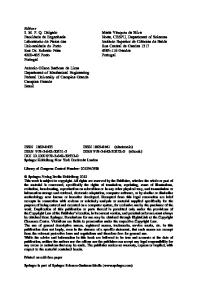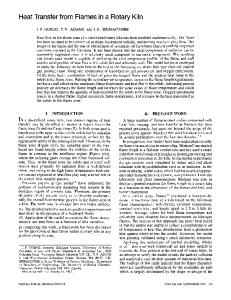Experimental study and numerical modeling of heat and mass transfer in rubberwood during kiln drying
- PDF / 1,225,766 Bytes
- 12 Pages / 595.276 x 790.866 pts Page_size
- 78 Downloads / 338 Views
ORIGINAL
Experimental study and numerical modeling of heat and mass transfer in rubberwood during kiln drying Santi Khamtree 1 & Thanate Ratanawilai 1
&
Chayut Nuntadusit 2 & Hormoz Marzbani 3
Received: 16 May 2019 / Accepted: 15 September 2020 # Springer-Verlag GmbH Germany, part of Springer Nature 2020
Abstract Rubberwood (Hevea brasiliensis) is a major raw material used in furniture factories in southern Thailand. Proper kiln drying of the lumber plays a significant role on the efficient utilization of the final product. Overall quality-reducing defects in such a materials are inevitable, unless a correct and proper drying process is used. Therefore, the objective of the present study was to develop a three-dimensional numerical model of heat and moisture transfer during the drying process and to conduct physical experiments in order to compare the results between the two approaches. For this purpose, an innovative kiln dryer was designed in the laboratory which will also contribute to the prevention of defects in the wood. The results show that the samples dried at a temperature of 120 °C experienced faster decreases in their moisture content compared to those dried at temperatures of 100 °C and 80 °C. The drying temperature and moisture content of the samples were successfully predicted by the simulation model created in this investigation and the two approaches demonstrated good agreement for temperature and moisture with root mean square errors of 0.50 and 0.19, standard errors of 0.38 and 0.16, and mean absolute errors of 0.94 and 2.18, respectively. These results will help rubberwood drying facilities prevent wood deformation while reducing the drying time required. Keywords Rubberwood . Heat transfer . Mass transfer . Kiln drying . Simulation
Nomenclature C Concentration kg/m3 Cp Specific heat J/kg·K D Diffusion coefficient m2/s Deff Effective diffusivity m2/s Ea Activation energy of material J/mol hT Heat transfer coefficient W/m2·K hm Mass transfer coefficient m/s ρg Body force N/m3 k Thermal conductivity W/m·K p Pressure Pa u Velocity in x direction m/s v Velocity in y direction m/s
w t T L Q x, y, z Nu Pr Re Sh Sc
* Thanate Ratanawilai [email protected]
Greek symbols ρ Density kg/m3 μ Viscosity of air kg/m/s
1
Department of Industrial Engineering, Faculty of Engineering, Prince of Songkla University, Hat Yai, Songkhla 90112, Thailand
2
Department of Mechanical Engineering, Faculty of Engineering, Prince of Songkla University, Hat Yai, Songkhla 90112, Thailand
3
School of Engineering, RMIT University, Melbourne, Australia
Velocity in z direction m/s Tangential to a surface Temperature K Length m Heat source W/m3 Cartesian coordinates m Nusselt number Prandtl number Reynolds number Sherwood number Schmidt number
Subscripts f Fluid s Solid a Air
Heat Mass Transfer
1 Introduction Rubberwood (Hevea brasiliensis) is the important tree species grown in South-east Asian countries. However, in common with other wood species, unless lumber from rubberwood is dried properly it cannot be use
Data Loading...











